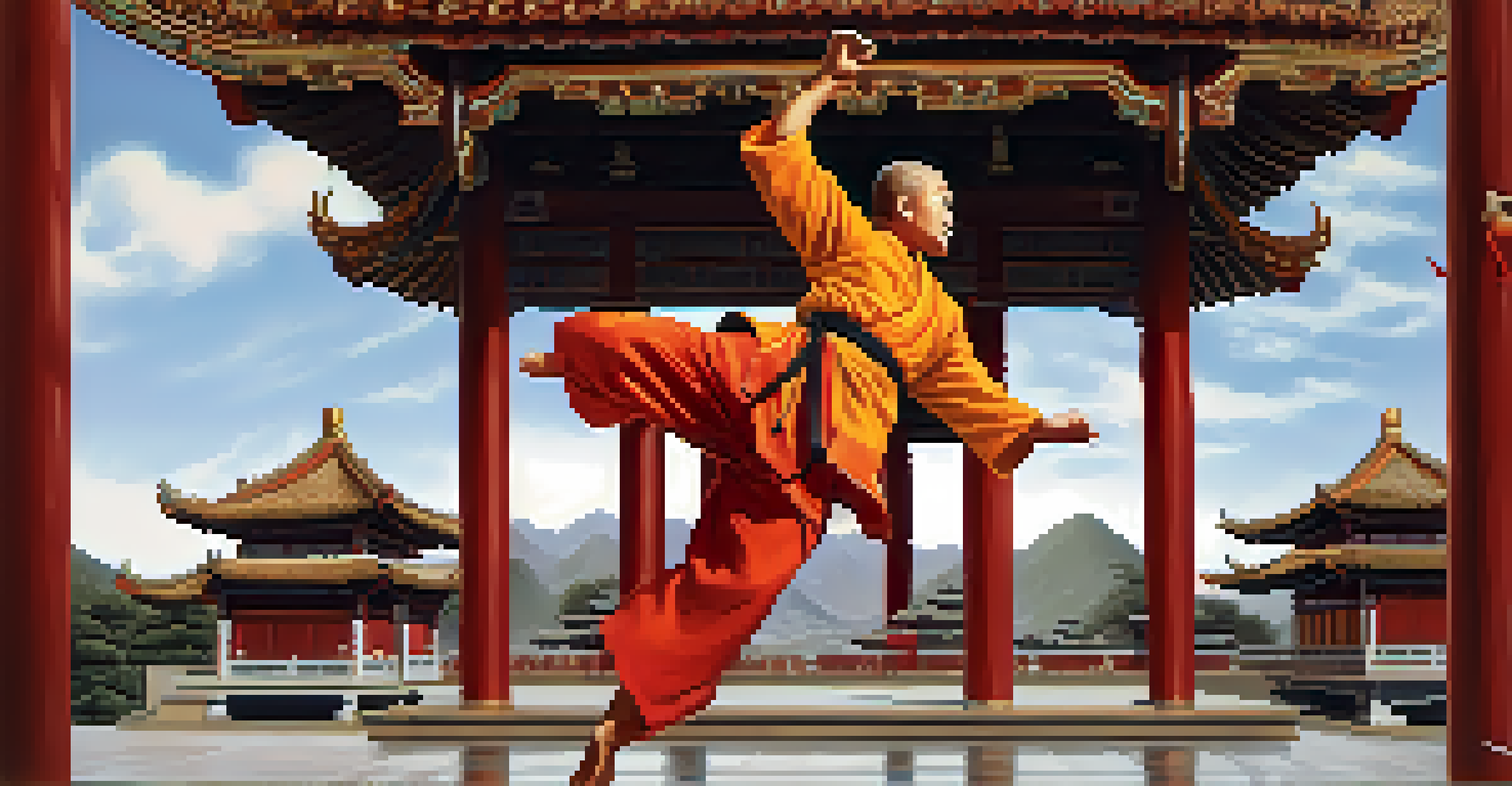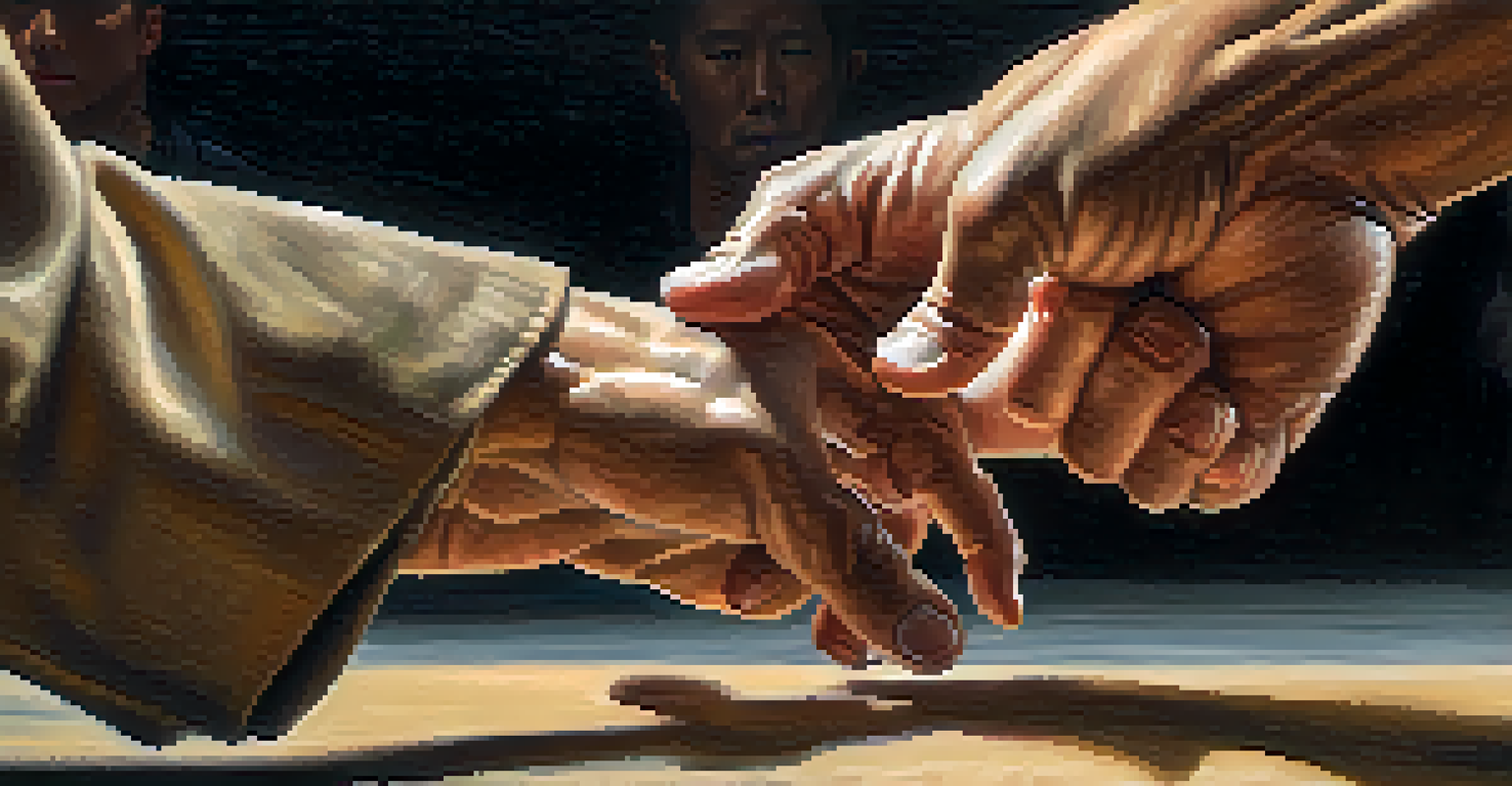Kung Fu Styles: Exploring Techniques and Philosophical Roots

Introduction to Kung Fu: A Rich Heritage of Martial Arts
Kung Fu, often recognized as a symbol of Chinese martial arts, encompasses a variety of styles, each with its unique techniques and philosophies. It's not merely about physical combat; it's a profound journey into self-discipline, spirituality, and cultural history. This ancient practice dates back thousands of years, evolving through dynasties while absorbing influences from various Chinese philosophies, such as Confucianism and Taoism.
The journey of a thousand miles begins with one step.
As we explore different Kung Fu styles, we’ll see how each reflects an aspect of Chinese culture and thought. Some styles emphasize soft movements for internal strength, while others focus on hard techniques for formidable combat skills. Regardless of the style, the core philosophy of Kung Fu remains rooted in the pursuit of harmony between body and mind.
In this article, we will delve into various Kung Fu styles, examining their distinct techniques and the philosophical underpinnings that guide practitioners. By understanding these elements, we can appreciate how Kung Fu transcends mere physicality to become a holistic approach to life.
Shaolin Kung Fu: The Foundation of Many Styles
Shaolin Kung Fu is perhaps the most famous style, known for its rigorous training and disciplined approach. Originating from the Shaolin Temple in Henan province, it combines martial prowess with Buddhist philosophy. The monks trained rigorously, developing both physical techniques and mental resilience, which laid the groundwork for many modern martial arts.

The techniques in Shaolin Kung Fu include a variety of strikes, kicks, and acrobatic movements, showcasing both strength and agility. This style emphasizes the importance of balance and fluidity, encouraging practitioners to flow seamlessly between offensive and defensive maneuvers. The philosophy behind these techniques teaches practitioners about perseverance and the importance of inner peace.
Kung Fu: More Than Just Fighting
Kung Fu transcends combat techniques, embodying a rich philosophical framework that nurtures both body and mind.
Moreover, Shaolin Kung Fu incorporates forms, or 'taolu', which serve as both a method of practice and a way to convey the deeper lessons of the art. Each form tells a story and represents specific principles of combat and philosophy, making it a rich tapestry of culture and martial skill.
Wing Chun: Efficiency and Directness in Combat
Wing Chun is a Southern Chinese martial art that stands out for its focus on practicality and efficiency. Unlike many styles that emphasize strength, Wing Chun teaches practitioners to use their opponent's force against them, making it accessible to individuals of all sizes. This technique-driven approach is often illustrated through its famous 'sticky hands' practice, which enhances reflexes and sensitivity to opponents' movements.
Martial arts is not about fighting; it's about building character.
Developed by a woman named Yip Man, Wing Chun embodies a philosophy of adaptability and quick decision-making in combat. The techniques are straightforward and designed for real-life self-defense situations, proving that sometimes less truly is more. This efficiency is a core tenet, allowing practitioners to engage effectively without unnecessary movements.
Moreover, the underlying philosophy of Wing Chun promotes mental clarity and emotional control, both critical for successful practice. It encourages students to stay calm under pressure and respond to threats with a clear mind, showcasing the blend of physical skill and philosophical depth that defines Kung Fu.
Tai Chi: The Art of Slow Movement and Mindfulness
Tai Chi, often perceived as a gentle form of exercise, is rich in martial techniques and philosophical teachings. Unlike other Kung Fu styles that focus on speed and power, Tai Chi emphasizes slow, deliberate movements that cultivate internal energy, or 'qi'. This practice is as much about meditation as it is about martial arts, promoting relaxation and mindfulness.
The flowing movements of Tai Chi are designed to improve balance, flexibility, and overall well-being. Practitioners learn to control their breath and movements, creating a harmonious connection between body and mind. This meditative aspect is what attracts many to Tai Chi, as it provides both physical benefits and a pathway to inner peace.
Diverse Styles Reflect Cultural Depth
Each Kung Fu style, from Shaolin to Tai Chi, showcases unique techniques and philosophies that reflect various aspects of Chinese culture.
Philosophically, Tai Chi embodies the principles of Yin and Yang, teaching the importance of balance in all aspects of life. The slow movements encourage practitioners to reflect on their internal state, making Tai Chi not just a martial art but a lifestyle that fosters tranquility and self-awareness.
Bagua Zhang: Circular Movements and Strategic Thinking
Bagua Zhang, or 'Eight Trigram Palm', is a unique Kung Fu style characterized by its circular movements and footwork. Practitioners often walk in a circle, executing techniques that emphasize evasion and fluidity. This style is not only about physical agility but also about strategic thinking, as it encourages practitioners to anticipate their opponent's moves and react accordingly.
The training involves intricate footwork and dynamic postures, which can seem whimsical at first glance. However, beneath the surface lies a deep philosophical understanding of change and adaptability. The circle symbolizes the cyclical nature of life, and Bagua practitioners learn to navigate challenges with grace and foresight.
Engaging in Bagua Zhang cultivates a sense of awareness and mindfulness, as practitioners must remain attuned to their environment. This connection to the philosophy of constant change makes Bagua not just a martial art but a metaphor for life itself, teaching resilience and adaptability in the face of adversity.
Hung Gar: Strength and Endurance in Martial Arts
Hung Gar is a traditional Southern style of Kung Fu known for its strong stances and powerful strikes. It's often associated with the famous 'Tiger and Crane' systems, which symbolize ferocity and grace. Hung Gar emphasizes physical strength, endurance, and a deep-rooted connection to one’s heritage, making it as much about personal growth as it is about martial prowess.
Practitioners of Hung Gar engage in rigorous training that often includes forms, sparring, and conditioning exercises. The techniques are grounded in powerful stances that enhance stability and force, allowing students to deliver effective strikes. This physicality is complemented by a philosophical approach that values discipline, respect, and humility.
A Journey of Personal Growth
Practicing Kung Fu promotes resilience, adaptability, and self-improvement, influencing how individuals approach challenges in daily life.
The philosophy behind Hung Gar teaches practitioners about perseverance and the importance of a strong foundation, both physically and mentally. This blend of toughness and tradition allows Hung Gar students to not only become skilled fighters but also respectful individuals who carry the values of their art into everyday life.
The Philosophical Roots of Kung Fu: More Than Just Fighting
At its core, Kung Fu embodies a rich philosophical framework that transcends combat techniques. Drawing from ancient Chinese philosophies, it emphasizes values such as respect, humility, and self-discipline. Practitioners are encouraged to reflect on their actions and develop a strong moral compass, making Kung Fu a holistic practice that nurtures both body and mind.
Each style of Kung Fu has its unique philosophical angle, often influenced by the teachings of Confucianism, Taoism, and Buddhism. For instance, the balance of Yin and Yang in Tai Chi illustrates the importance of harmony in life, while the focus on internal strength in Wing Chun emphasizes mental clarity. This philosophical depth enriches the practice, guiding students on their martial arts journey.

Kung Fu teaches life lessons through its techniques, encouraging practitioners to face challenges with resilience and wisdom. Whether through the discipline of Shaolin or the mindfulness of Tai Chi, the philosophical roots of Kung Fu provide a framework for personal growth, making it a lifelong journey of self-discovery and mastery.
Conclusion: Embracing the Journey of Kung Fu
Exploring the various styles and philosophies of Kung Fu reveals a rich tapestry of martial arts that goes beyond mere fighting. Each style carries its unique techniques, yet they all share common threads of self-discipline, respect, and personal growth. This journey into Kung Fu is not just about mastering physical skills but also about understanding oneself and one’s place in the world.
As practitioners delve into the teachings of Kung Fu, they embark on a path that promotes physical fitness, mental clarity, and spiritual growth. The lessons learned extend far beyond the dojo, influencing how individuals approach challenges in daily life. Whether it’s the tenacity of Hung Gar or the fluidity of Tai Chi, each style offers valuable insights into living a balanced and fulfilling life.
Ultimately, embracing Kung Fu means committing to a lifelong journey of learning and self-improvement. It’s a practice that fosters resilience, adaptability, and harmony, encouraging individuals to strive for excellence in every aspect of life. So, whether you're drawn to the graceful movements of Tai Chi or the powerful strikes of Shaolin, remember that the true essence of Kung Fu lies in the journey itself.